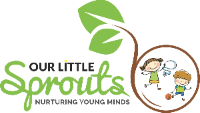How Can Storytelling Unlock the Potential of Preschoolers?
- Our Little Sprouts

- Feb 26, 2024
- 3 min read
Updated: Feb 28, 2024
Ignite young minds with the magic of storytelling! In the vibrant world of preschool, captivating narratives become powerful tools for fostering early literacy through new vocabulary and engaging sentence structures. They fuel language development as children actively listen and participate. Moreover, stories spark emotional intelligence by helping children navigate their own feelings and understand those of others. The seeds of curiosity and a lifelong love for learning are sown through these immersive experiences, making storytelling a cornerstone of a rich preschool education.

10 creative storytelling ideas for preschoolers:
Story Stones: Gather smooth stones and paint simple images on them (characters, settings, objects). Children can randomly select stones and build a spontaneous story around the images.
Sensory Storytelling: Fill a box with objects of various textures, smells, and sounds. Have children explore the box as you weave a story incorporating the sensory elements.
Storytelling Props: Gather a collection of interesting objects (hat, toy animal, picture frame, etc.). Children pick a prop and contribute a part of the story related to the object.
Draw and Tell: Start a drawing and pass it around, letting each child add to the illustration while also contributing a sentence to the story.
Story Chain: Start a story with a single sentence. Each child takes a turn adding one more sentence to build a collaborative narrative.
Act It Out: Provide simple costumes and props. Kids select roles and act out a favorite storybook or create their own.
Shadow Puppet Play: Create cut-out shapes and narrate a story with the shadows they cast on a screen or wall.
Musical Storytelling: Use simple instruments to create sound effects as a story is told. Alternatively, turn a familiar song into a new narrative by changing the lyrics.
Picture Book Remix: Take a familiar picture book and change one element (e.g., the setting, a character's trait). Children reimagine the story based on the change.
"What If...?" Scenarios: Pose a "what if" question (e.g., "What if animals could talk?") and let children brainstorm a story based on this fantastical idea.
Our Little Sprouts can help young learners to experience the magic of storytelling in variety of ways:
Incorporate Storytelling into the Curriculum:
Daily Story Time: Dedicate dedicated time each day for teachers to read high-quality children's books with engaging voices and expressions.
Interactive Storytelling: Encourage active participation during story time. Use puppets, props, or ask questions to spark engagement and connection to the narrative.
Themed Storytelling Weeks: Plan weekly themes around specific topics and incorporate storytelling activities like creating stories based on the theme, visiting a local storyteller, or inviting parents to share stories related to their cultural backgrounds.
Storytelling Integration: Weave storytelling into different areas of the curriculum. For example, use storytelling to illustrate science concepts, social-emotional learning lessons, or create narratives based on math concepts like counting and sequencing.
Create a Storytelling-Friendly Environment:
Storytelling Corner: Designate a cozy space with comfortable seating, shelves filled with diverse picture books, and engaging visuals like story maps or character posters.
Dress-Up Box: Provide a variety of costumes and props to allow children to dress up as characters from their favorite stories or act out their own created narratives.
Art & Music Integration: Encourage children to use art materials to depict scenes from stories or express their understanding through drawings, collages, or paintings. Similarly, incorporate music or create sound effects to enhance storytelling experiences.
Puppet Theater: Provide a designated space with a puppet theater backdrop and a variety of puppets to encourage children to create and perform their own stories.
Promote Storytelling at Home:
Parent Workshops: Organize workshops for parents to share the benefits of storytelling and equip them with practical tips and resources to engage in storytelling at home.
Storytelling Kits: Create themed storytelling kits with props, puppets, and picture book suggestions to lend to families and encourage them to continue storytelling experiences outside the classroom.
"Read Aloud" Challenge: Encourage families to participate in a "Read Aloud" challenge, tracking the number of books read each week and celebrating milestones.
"Storytelling Night" Events: Host monthly "Storytelling Night" events where parents, teachers, and even children can share stories with the entire school community.
For more such interesting blogs, Visit Our Little Sprouts




Comments